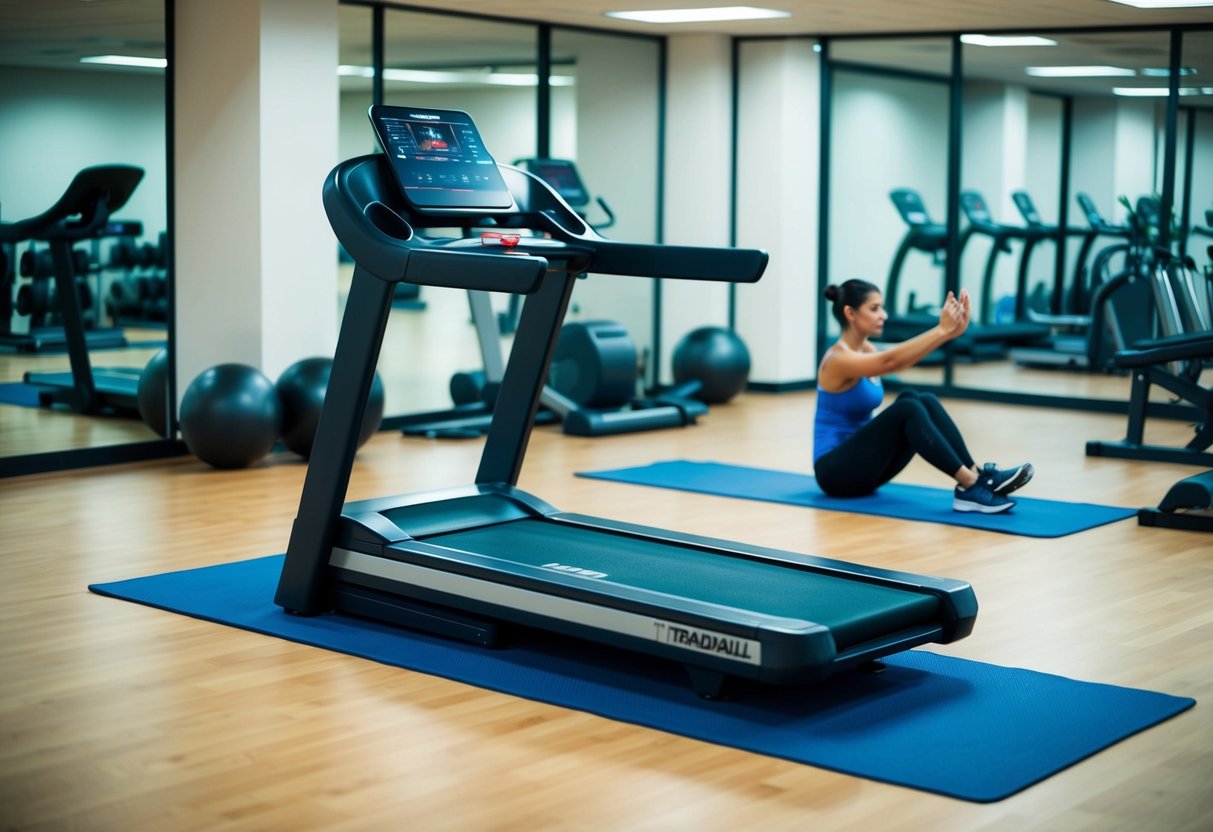Proper Warm Up and Cool Down Routines for Treadmill Users
Don’t forget to check out our Pacerocker , Trailviber, and Trailviber with 12% 9-Level Incline walking pad treadmills.
Treadmill workouts are a popular choice for many of us who want to stay fit, but how often do we think about the importance of warming up and cooling down?
Proper warm-up and cool-down routines are essential to optimize performance and prevent injury. By incorporating these routines, we set ourselves up for a more efficient and enjoyable workout experience.
When we consider our warm-up and cool-down as integral parts of our exercise regime, we’re investing in our long-term fitness journey. These routines help prepare our body by gradually increasing heart rate and flexibility, and they aid in recovery afterward. This not only enhances performance but also supports muscle health, thereby reducing the risk of strains and injuries.
Crafting an effective warm-up and cool-down routine isn't just reserved for elite athletes—it's something we can all benefit from as part of our treadmill workouts.
Let’s embrace these foundational components, ensuring we get the most out of every session and walk away feeling accomplished and injury-free.
Key Takeaways
-
Warm-ups prepare the body for exercise and prevent injuries.
-
Cool-downs aid in recovery and support muscle health.
-
Integrating both improves overall workout performance.
Understanding the Importance of Warm-Up
A proper warm-up is crucial for treadmill users as it prepares the body for exercise and reduces the risk of injury. By enhancing circulation and flexibility, warm-ups contribute to better workout performance.
Benefits of a Proper Warm-Up
Engaging in a warm-up session before hitting the treadmill offers numerous benefits. First, it increases our heart rate gradually, enhancing blood flow to muscles. This improved circulation helps deliver essential oxygen and nutrients, preparing our muscles for more intense activity.
Additionally, warm-ups increase joint lubrication, contributing to better flexibility and movement efficiency. As we warm up, there's an increase in muscle temperature, which aids in the contraction and relaxation of muscle fibers. This results in improved performance and coordination. In essence, a proper warm-up makes our workouts more effective and enjoyable.
Potential Risks of Skipping Warm-Up
Skipping a warm-up can lead to several potential risks for treadmill users. Without it, our muscles and joints remain stiff, increasing the likelihood of strains or sprains.
Cold muscles are less elastic and more prone to tears. Additionally, bypassing a warm-up can lead to inadequate oxygen supply to our muscles, making us feel fatigued faster and reducing overall workout efficiency.
We're also at risk of experiencing muscle cramps or discomfort, as our body isn't adequately prepared for the physical demands. Neglecting warm-up increases the chance of cardiovascular issues during exercise due to a sudden spike in heart rate. Warm-ups act as a safeguard, preparing both body and mind for a successful workout.
Designing Your Warm-Up Routine
When we step onto the treadmill, preparing our bodies with a warm-up routine is essential. This not only enhances performance but also minimizes the risk of injury.
Let's look into the essentials that benefit us in a structured warm-up.
Dynamic Stretching Essentials
Dynamic stretching is crucial for us to increase flexibility and range of motion. By moving our joints through continuous motion, we warm up muscles and prepare them for exercise. Key stretches include leg swings and arm circles.
Leg Swings: Stand next to the treadmill and swing each leg forward and backward for 20 reps.
Arm Circles: Perform large circles with each arm for 10 reps.
These motions help increase blood flow and muscle oxygenation, readying our body for running.
Cardio Warm-Up Techniques
Light cardio activities get our heart rate up and prepare us for a treadmill workout. We begin with a brisk walk or slow jog for 5-10 minutes. This helps gently elevate our heart rate and ready our cardiovascular system.
During this phase, we should maintain a pace that allows us to converse. This light activity enhances circulation and primes muscles without bringing fatigue.
Targeted Muscle Activation
Activating specific muscle groups is vital for those of us using treadmills. Focus on activating the core, glutes, and calves.
Marching in Place: Lift knees to hip level, alternating for one minute.
Heel Raises: Stand on toes and hold for a few seconds before lowering.
Ensuring engagement of these muscles avoids strain and supports form. This approach prepares our muscles for the exertion to follow during the treadmill session.
Executing the Warm-Up
When using a treadmill, a well-executed warm-up enhances performance and reduces the risk of injury. Key focus areas include duration and intensity tailored to our fitness level, orderly exercises, and monitoring heart rate for efficiency.
Warm-Up Duration and Intensity
The initial step is setting an appropriate duration and intensity. Typically, a warm-up should last between 5 to 10 minutes. For an effective start, we often begin at a brisk walk or slow jog, maintaining a pace that slightly elevates our heart rate. This approach gradually increases body temperature and prepares muscles for the workout.
It's important to listen to our body and adjust as needed. If new to treadmill exercise, we might opt for a longer duration at a lower intensity.
Sequencing Your Exercises
Organizing our exercises is crucial for maximizing the benefits of our warm-up. We can start with dynamic stretching to activate major muscle groups like the hamstrings and quadriceps.
Following this, we might incorporate movements such as high knees or butt kicks to enhance range of motion. Transitioning to treadmill-specific activities like walking lunges or side shuffles can further prepare our muscles. By strategically sequencing exercises, we ensure an efficient warm-up tailored to the upcoming workout demands.
Monitoring Your Heart Rate
Keeping an eye on our heart rate is pivotal for an effective warm-up. Ideally, we aim to reach 50-60% of our maximum heart rate during this phase.
Using wearable technology, we can easily track these metrics for better precision. This ensures we're neither underexerting nor overexerting ourselves.
If wearables aren't available, we might manually check our pulse or simply rely on how we feel – slightly out of breath but comfortable. Monitoring helps optimize our performance while avoiding fatigue.
Transitioning to the Main Workout
Transitioning from the warm-up phase to the main workout on a treadmill is a crucial step where we set our pace and optimize our performance. It's about gradually increasing both speed and incline to align with our fitness objectives and desired intensity for the session.
From Warm-Up to Treadmill Training
Once we've completed our warm-up, it’s time to smoothly shift into treadmill training. At this stage, it's vital to adjust both our speed and tempo progressively. This gradual progression helps our bodies adapt to the increased demand, reducing the risk of injury.
Start by evaluating our energy levels and current fitness goals. Based on this assessment, we can decide the pace that's effective yet sustainable.
Proper hydration, wearing suitable footwear, and maintaining good posture are essential. These factors are key to ensuring our safety and enhancing our workout experience.
Adjusting Speed and Incline
To stimulate various muscle groups and enhance cardiovascular endurance, tweaking speed and incline is necessary. We should aim for a balance that challenges us without overexerting ourselves.
A good approach is to adjust the incline by increments, mimicking uphill walking and increasing resistance.
In terms of speed, starting with a brisk walk and gradually moving to a jog or faster pace suits most fitness levels.
It's beneficial to monitor our heart rate, ensuring it aligns with the target zone. This method allows us to effectively maximize our treadmill session, meeting both cardio and strength-training needs.
Cool-Down Fundamentals
Cooling down after a treadmill workout is crucial to help return our bodies to a resting state and prevent injuries. We can choose from a range of methods to ensure we recover actively and effectively.
Importance of Gradual Cool-Down
Gradual cooling down allows our heart rate to decrease slowly, preventing dizziness or light-headedness. Starting with a slow walk for 5-10 minutes helps in maintaining blood circulation and reducing muscle stiffness.
Contrasting sharp stops with a progressive decrease supports joint flexibility and minimizes post-exercise soreness. We benefit when we consciously focus on our breath, promoting relaxation from the workout intensity.
Consistently incorporating a cool-down routine can significantly enhance our recovery process.
Active Recovery Options
Incorporating active recovery during cool-down helps our muscles to recover faster and improves overall endurance. Options like walking at a reduced pace or incorporating gentle stretches target major muscle groups used during the workout.
Stretching exercises can include:
-
Hamstring stretch: Sit down, extend a leg forward, and reach towards your toes.
-
Quad stretch: Stand on one leg and pull your heel to your glutes.
-
Calf stretch: Step forward with one foot and press the back heel down.
These activities enhance flexibility and circulation. We should listen to our bodies and adapt our routines based on our specific fitness levels and goals.
Effective Cool-Down Techniques
We need effective cool-down techniques to conclude our treadmill sessions safely. By focusing on proper stretching, gradually reducing our walking pace, and incorporating breathing exercises, we can facilitate a smoother transition from intense activity to rest. These steps can help prevent injury and promote relaxation.
Stretching to Prevent Stiffness
After our treadmill workout, stretching is key to avoid stiffness and maintain flexibility. Focus on dynamic stretches for major muscle groups like quads, hamstrings, calves, and hip flexors.
Use a wall or a sturdy surface for balance, if needed, when stretching the quads and calves individually to ensure each muscle group is properly targeted.
It's crucial to avoid overstretching. Let's hold each stretch for about 20-30 seconds and repeat 2-3 times on each side.
Ensure the movements are slow and controlled, focusing on deep, steady breathing to enhance the stretch's effectiveness. This method will relieve tension build-up and promote circulation.
Walking Pace Reduction Strategy
We should transition into a walking pace reduction strategy by gradually decreasing our treadmill speed to help our heart rate return to normal.
Start by slowing down to 60-70% of our top running speed for approximately 2-3 minutes. Continue to decrease the pace until we reach a comfortable stroll.
Monitor how our breathing and heart rate adjust during this period. Aim to maintain this gentle walking pace for another 5 minutes while focusing on our posture.
Keep shoulders relaxed and maintain a natural stride. This approach will aid in reducing the risk of dizziness and maintain a steady blood flow.
Breathing Exercises for Relaxation
Breathing exercises help us relax and encourage optimal oxygen flow post-workout.
Let's start by sitting comfortably and practicing diaphragmatic breathing. Inhale deeply through the nose, allowing our diaphragm to expand, and hold for 2 seconds before exhaling slowly through the mouth.
Engage in this deep breathing for 5 minutes to promote relaxation. Gradually, incorporate a pattern like 4-7-8 (inhale for 4 seconds, hold for 7, exhale for 8).
Focus on clearing our mind, which can enhance the calming effect. Implementing these exercises after our treadmill routine can significantly boost recovery and relaxation.
Integrating Cool-Down Into Your Routine
To wrap up our treadmill sessions effectively, we need to focus on a proper cool-down. We’ll look into the ideal timing and steps for cooldowns, coupled with strategies for rehydration and refueling.
Cool-Down Duration and Timing
The cool-down phase allows our bodies to transition from exercise to rest smoothly. A 5 to 10-minute walk at a slower pace than our workout helps reduce heart rate and prevent blood pooling. This gradual decrease in intensity facilitates recovery and reduces soreness.
Stretching major muscle groups once our heart rate slows is beneficial. Key areas include calves, quadriceps, hamstrings, and shoulders. Incorporating these stretches increases flexibility and lowers injury risk. Consistency in cooldowns fosters improved overall performance.
Post-Workout Hydration and Nutrition
Hydrating immediately after exercise is essential. Replenishing fluids lost through sweat aids recovery.
It’s advisable to drink at least 16-24 ounces of water post-workout. Sports drinks with electrolytes might be suitable if we’ve sweated heavily.
In terms of nutrition, consuming a balanced meal within 30-45 minutes post-exercise is beneficial. Including proteins and carbohydrates helps repair muscles and replenish glycogen stores.
A simple smoothie or a serving of yogurt with fruit can be an effective choice for this crucial recovery window.
Frequently Asked Questions
We've gathered common questions that can enhance your treadmill workout routine. These cover warm-up exercises, the use of incline, and important cool-down techniques.
What are some effective warm-up exercises to do before starting a treadmill workout?
Starting with a brisk walk or light jog helps get the blood flowing. Dynamic stretches like leg swings or arm circles prep our muscles for the workout ahead.
How long should my warm-up on the treadmill last?
We suggest a warm-up of about 5 to 10 minutes. This duration gets our body ready for more intense exercise while reducing injury risk.
Is it beneficial to use an incline during my treadmill warm-up?
Using a slight incline can intensify our warm-up. It activates different muscle groups and increases the cardiovascular challenge.
Why should I warm up before doing a leg-oriented treadmill session?
Warming up is crucial for preparing our leg muscles. It boosts flexibility and circulation, which can enhance performance and prevent strains or pulls.
Can you suggest some post-treadmill stretches for cooling down?
Gentle stretches targeting the calves, hamstrings, and quadriceps are useful. Holding each stretch for 15 to 30 seconds aids recovery after an intense session.
What are some tips for a proper cool-down routine after using a treadmill?
Gradually decreasing speed over 5 minutes helps bring our heart rate down. Following up with static stretches ensures our muscles recover and stay flexible.
Boost performance and prevent injuries with proper warm-up and cool-down routines for treadmill users. Learn essential tips to enhance your fitness journey!



Share:
Mastering Treadmill Running Form: Tips for Proper Technique